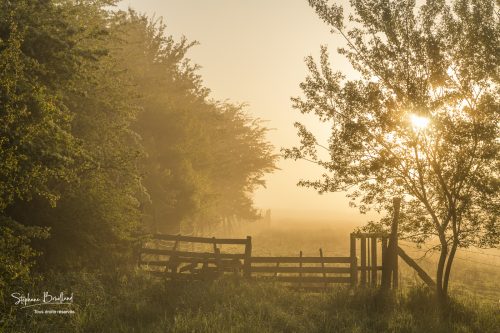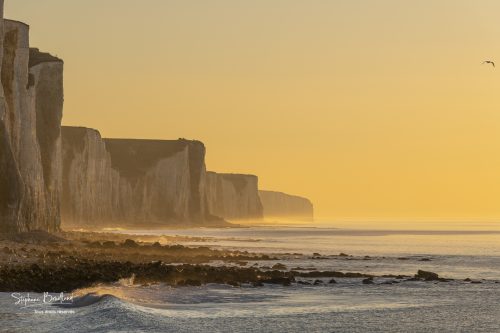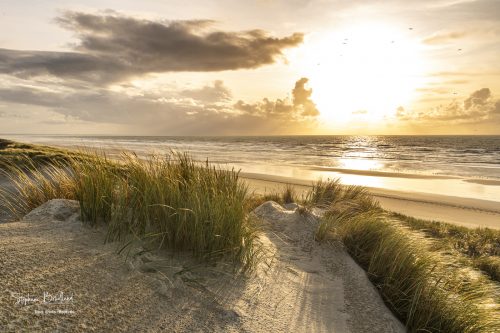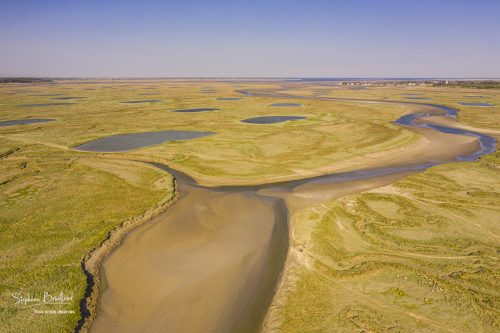Landscape photography in the bay of the Somme
Landscape diversity
It is one of the richness of the Bay of the Somme to offer to the photographer a variety of very different landscapes that coexist for a few kilometers along the Picardy coastline. The amateur landscape photographer is charmed in the bay of the Somme! Although the Somme estuary occupies only a part of the Picardy coast, the term "Baie de Somme" has come to prevail in the common language. The "Bay de Somme" also designates almost the entire coastline of Picardie Maritime.
Here, you can go from cliffs to the beach, from marshes to dunes, from woods to pebbles, in a few dozen minutes by car. The play of the tides completely modifies the landscapes on the coast and in the bay, the seasons color the vegetation differently and the time of day conditions the lighting. These constantly renewed landscapes are therefore a permanent source of inspiration for the photographer as illustrated in this portfolio.
It is thus possible to regularly visit the same places and to bring back very different images each time, given the different combinations of these elements. The coastline faces west, ideal for sunsets over the sea, but the estuary is perpendicular to the coast. With experience and according to the images that one have in mind, one learn to direct one's steps rather to the north or rather to the south, to benefit from the desired lighting, just as one learn to integrate the hours and tidal coefficients.
The low fields
In this diversity of landscapes, we find, on the periphery of the Bay de Somme, the "low fields", local name given to the land gained from the sea over the centuries. The bay itself is, in fact, today surrounded by a dyke that blocks the sea's advance during high tides. These wet pastures are criss-crossed by ditches and small channels and are dotted with ponds and pools, sometimes with old half-submerged fences, probably more symbolic than effective.
The morning fog-laden atmospheres are particularly photogenic and it is easy to take advantage of the reflections of the colored sky in the water. The Scottish Cows with long hair (Highland Cattle) and the Henson horses, this local breed with a beautiful beige and golden coat, so well adapted to equestrian tourism, populate these meadows and give life to the images. Around the bay, most of the landscapes bear the imprint of men since they are lands that have been reclaimed from the sea.

The Somme, channeled between Abbeville and Saint-Valery-sur-Somme, offers a long straight perspective. It carries the glance away and allows to play with the fleeing ones. Along this canal extend the marshes of the lower Somme with a multitude of ponds. This maintained and domesticated nature is nevertheless rich in possibilities for landscape photography. This is especially true in autumn and spring when the sun pierces the fog and the ghostly silhouettes of trees gradually emerge from the mist.
The chalk coast and the cliffs

To the south of the bay, a radically different landscape is offered to the eye with the cliffs that then extend to Normandy. The flints extracted from the limestone by the action of the sea form the pebbles, which roll under the effect of the currents and are found piled up to the point of Hourdel in a natural cordon that protects the land. On sunny days, the white limestone takes on a beautiful golden hue when it is illuminated by the setting sun.
The top of the cliffs is one of the few high points in the region for landscape photography. The customs officers' path opens up numerous perspectives in which the undulating and hilly profile of the coastline snakes into the distance.
Approaching the edge is strongly discouraged because of the risk of landslides, but it is very difficult to resist the urge to take a few pictures at a wide angle... At the foot of the cliffs, the risk is better measured by discovering the landslides and the scattered chalk blocks. At high tide, the waves break on these blocks, offering the possibility to put movement in the images by freezing the splashes or the foam that flies away.
At low tide, it is the chalky plateau eaten away by the sea and from which flint emerges that is open to view. The uneven ground is streaked with cracks, where the most friable limestone has disappeared, which guide the eye. This is one of the few places on the coast where the use of neutral filters is interesting to obtain long exposure effects on moving water.
Indeed, the rocks offer a contrast of sharpness and immobility with the fuzzy and dynamic liquid element. A well-balanced and stable tripod is necessary. Contrary to what happens in a torrent, here the waves regularly come to jostle it. The risk of vagueness is not negligible. The sun setting in the alignment of the cliffs offers warm colors. They color the clouds and complete the dreamlike aspect of the images thus produced. The polarizing filter allows to further enhance this sensation. I confess, for my part, to use it only very rarely, the result often deviating too far from reality, to my taste.
Le Marquenterre
A few tens of kilometres away, in the north of the bay, there is the Marquenterre. Here, the landscape is made up of dunes on which the vegetation varies as one moves away from the seaside and the salt spray. The white, mobile dunes are partially covered with oyats which undulate in the wind, the sea-buckthorn trees whose orange berries colour the landscape in autumn come next, finally giving way to wooded dunes. The gentle curves of the dunes allow for harmonious compositions and a small 70-200 type telephoto lens makes it possible to clearly separate the different shots. The place is frequented by horse riders on hikes, who are interesting to include in the pictures, both to provide a scale factor and to give life to the landscape.
Here also, men have left their mark on the landscape, and the low tide reveals the 50,000 bouchots planted for the breeding of the moulds. These geometrical alignments are not devoid of graphic possibilities and the technique of long laying gives interesting results.

The Somme estuary and the bay
At the center of these two so different landscape units is the Somme estuary itself. Here everything is flat, impossible to gain altitude. To embrace the bay from the view, you have to go to one of the two orientation platforms of Le Crotoy or Saint-Valery. Only the drone can discover the meanders of the channels at low tide. Two different environments are found here: the schorre and the slikke.

The schorre is the peripheral part of the estuary, covered with halophilic plants, this area is commonly referred to as "foreshore". This foreshore reflect the progressive silting up of the bay and are only covered by the sea during high tides. The foreshore sheeps, the channels... are as many foregrounds that can be included in the compositions. In June/July, the wild staticein bloom form vast purple carpets of the most beautiful effect.
The slikke, discovered at low tide, is on the other hand much more difficult to photograph. It is not easy, indeed, to make images of this flat and empty expanse, which are not, themselves, ... flat and empty! The foregrounds that give depth to the image are rare, and it is necessary to take advantage of every possible relief: clumps of Spartina or Salicorne, shells, birds or even characters. In the absence of foreground, the micro-reliefs of the ground take all their importance.
The sand sculpted by water and wind thus offers a wide variety of graphic motifs ranging from simple undulations to an almost lunar cracked relief. The multiple sinuous channels guide the eye and are as many perspectives to be exploited for the construction of the images. In these stripped-down compositions, the skies and the quality of the light also become essential for the picture to catch the attention. Cloudy skies then offer many more possibilities than the sunny days. Coloured clouds are reflected in puddles, light gaps allow for chiaroscuro effects... Bay storms can thus transform the landscape and give it a dramatic aspect that one will happily capture. Be careful, however, if the thunder rumbles, you should leave the bay because the risk of being used as a lightning rod is certain!
Let's also remember that the tide rises quickly, that the currents are strong, that there is quicksand. It is really advisable to be informed of the risks before venturing into the bay. Several associations of nature guides are at your disposal for that. associations de guides-nature sont à votre disposition pour cela.
I have deliberately only dealt with landscape photography "on foot" in this article, but the Baie de Somme obviously offers many other possibilities for lovers of beautiful images. Birds are omnipresent and attract many wildlife photographers. The beaches of Cayeux, Le Crotoy, Quend and Fort-Mahon are very popular with kitesurfing and sand yachting adepts, disciplines that also offer the possibility to take beautiful pictures. Microlight lovers will undoubtedly find something to express themselves while flying over the bay. Finally, the Picardie people live in intimacy with their bay and the possibilities of portraits and reports will inspire the fans of Humanist photography.